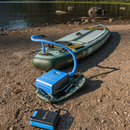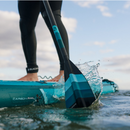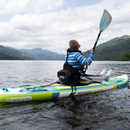Inflatable Vs Hard Paddle Boards: Which is Better?

“Are all paddle boards inflatable?” In fact, there are 2 main types of paddle boards - inflatable and hard board. Selecting between the two depends on various factors. To assist you in making a well-informed decision, our comprehensive guide compares inflatable paddle boards vs solid boards, empowering you to make the ultimate choice with confidence and a zest for adventure. Let's get started!
What are Inflatable vs Hard Paddle Boards?
So, what is the difference between an inflatable board and a solid paddle board?
Inflatable paddle boards, or iSUPs, are crafted from robust PVC material and boast an internal drop-stitch design. They spring to life when inflated and conveniently deflate for effortless storage and transport.
Conversely, hard paddle boards, constructed from materials like foam, fiberglass, or carbon fiber, bring rigidity and performance-driven features, ready to fuel your adventurous spirit on the water.

Inflatable Paddle Board Vs Solid: The Differences?
The debate between inflatable and solid paddle boards often starts with the question, "Are all paddle boards inflatable? Below is a comparison table between inflatable paddle board vs solid boards:
| ATTRIBUTE | INFLATABLE BOARDS | HARD BOARDS |
|---|---|---|
| Portability | Effortless to carry and transport when deflated | Bulkier and requires a suitable vehicle or storage solution |
| Stability | Stable in calm water | Offer better stability due to rigid construction |
| Speed | Nimble, but may not quite rival the speed of a hard board | Streamlined design and superior hydrodynamics for faster speeds |
| Maneuverability | More maneuverable due to lighter weight and responsive construction | Can be maneuverable but might require more effort |
| Durability | Durable with PVC material, yet susceptible to punctures from sharp objects | Durable due to robust construction |
| Storage Space | Easily deflatable and storable | Require dedicated storage solutions or ample space |
Ultimately, choose the paddle board based on your individual needs and preferences. Inflatable SUPs are more portable and easy to store, while hard boards offer excellent stability and speed. For all-around leisure paddling, inflatable boards are a better choice due to their durability, versatility, and injury prevention. If you're buying a board for SUP surfing or racing, consider the technical attributes of rigid boards.
=> Are you Interested in inflatable vs solid paddle boards but have yet to make up your mind? Check out our article on “are inflatable boards good?”
Advantages of Inflatable SUP Boards
Between inflatable paddle boards vs solid boards, here are the advantages of the iSUPs

Easy to Store and Transport
The biggest difference between inflatable paddle board and regular one is their portability. Inflatable paddle boards can be deflated and rolled up into a compact package that easily fits in a compact backpack, unlike their solid counterparts. They are ideal for those with limited storage space, such as apartment dwellers.
Transportation is a breeze as well. You can throw the bag in your car trunk, take it on public transport, or even check it in on a flight, opening up a world of paddling possibilities.
Softer than Solid Boards
While solid boards offer a classic feel, inflatable paddle boards provide a softer platform underfoot. It is a major benefit for beginners who are still finding their balance or those who plan on doing yoga or other fitness activities on their board. The inflatable core offers a slight cushion, making falls and accidental bumps less jarring.
Additionally, the traction pad on top of most iSUPs provides a grippy surface that's comfortable for kneeling or long periods of standing.
How Durable Are Inflatable Paddle Boards?
Despite their inflatable nature, iSUPs are surprisingly durable. What are inflatable paddle boards made of? Made from military-grade PVC materials, they can withstand bumps, scrapes, and even minor punctures.

The air chambers inside the board distribute pressure evenly, minimizing the risk of dings or cracks that can plague solid boards. Many iSUPs come with repair kits in case of accidental punctures, allowing for easy on-the-go fixes.
Offer Stability for Outdoor Activities
Inflatable paddle boards are known for their excellent stability. Their wider design and inflatable core create a more buoyant platform compared to some hard boards.
The increased stability makes them ideal for beginners learning to stand up paddle or for those who enjoy leisurely paddling on calm waters. Also, the stable platform makes them perfect for yoga, fishing, or taking your pet along for the ride when we compare an inflatable paddle board vs solid board.
Inflatable SUPs Are More Affordable than Solid Boards
In general, between an inflatable paddle board vs solid board, inflatable paddle boards tend to be a more affordable option.
While high-performance models on both sides of the spectrum can reach similar price points, entry-level inflatable paddle boards are typically more budget-friendly.
Being affordable makes them a more accessible option for those new to paddle boarding or those who want to try the sport without a significant upfront investment. The lower cost also makes them an attractive choice for casual paddlers who might not use their board as frequently as dedicated enthusiasts.

Disadvantages of Inflatables SUPs
While inflatable paddle boards offer numerous advantages, there are also a few drawbacks to consider. Inflating the board requires a pump, which can add some time and effort to getting out on the water (11-15 minutes), especially compared to simply grabbing a hard paddle board.
Additionally, when comparing an inflatable paddle board vs solid board, inflatable paddle boards can be slightly thicker (about 6 inches) than their hard counterparts. Moreover, they need to be fully dry before rolling up to avoid mold issues.
Finally, some experienced paddlers might find the inflatable construction to be less responsive for high-performance paddling, such as racing or surfing.
Advantages of Solid SUP Boards
Here are the advantages of hard SUP boards, which are different from inflatable paddle boards vs solid boards.
Performance and Speed
When considering "inflatable paddle board vs fiberglass," it's clear that fiberglass paddle boards deliver superior performance. They exhibit greater maneuverability, glide more smoothly through the water, and are the optimal choice for catching waves while SUP surfing.
Unlike inflatables that can flex slightly with each stroke, solid SUPs remain stable and cut through the water with minimal resistance.
Thus, solid SUPs are ideal for activities like racing, surfing, and long-distance paddling, where maximizing speed and efficiency is crucial.
Save Time
Between an inflatable paddle board vs solid board, solid SUP boards boast the advantage of being ready to go whenever you are. There's no need to spend time unpacking, inflating with a pump, and reaching the recommended air pressure – simply grab your board and head straight to the water.

This can be a game-changer for spontaneous paddling trips or when you have limited time on your hands. Solid SUPs also eliminate the potential frustration of pump malfunctions or slow leaks that can plague inflatable boards.
Always Firm Enough
Solid SUP boards maintain their shape and rigidity regardless of water conditions. Consistency provides a stable platform for paddling, even in choppy water or strong winds.
Inflatable SUPs, on the other hand, can flex and lose some rigidity when not inflated to their recommended pressure. You may feel less stable, especially if you are a beginner paddler or are less comfortable on the water.
The predictability of a solid SUP's firmness can boost confidence and enjoyment, allowing you to focus on paddling technique and exploring your surroundings.
Disadvantages of Solid SUPs
Solid SUP boards also come with some drawbacks. Their rigid construction makes them heavier and bulkier when we test and compare an inflatable paddle board vs solid board. This can make them more challenging to transport and store, especially for those with limited space.
Additionally, solid SUP boards can be more susceptible to damage from bumps and impacts due to their less forgiving nature compared to the inflatable counterparts.
How to Choose the Right Paddle Board?
To determine between inflatable paddle boards vs solid boards for your needs, consider the following factors that distinguish hard vs inflatable paddle boards:

Performance
Consider your paddling style and environment for inflatable vs solid paddle boards.
- Length: Longer boards (over 12ft) are ideal for flatwater cruising and racing, offering better speed and tracking. Shorter boards (under 10ft) are more maneuverable, suited for surfing waves or riding rivers.
- Width: Wider boards (over 32 inches) provide exceptional stability, perfect for beginners or choppy waters. Narrower boards (under 32 inches) prioritize speed and agility, ideal for experienced paddlers on calmer waters.
- Thickness: Thicker boards (over 6 inches) offer more volume, displacing more water and supporting heavier riders or carrying gear. Thinner boards (4-6 inches) are lighter and more efficient for paddling long distances.
Storage
Think about space availability and ease of storage between an inflatable paddle board vs solid board.
- Solid boards: These fiberglass or composite boards offer superior rigidity but require ample storage space due to their fixed size. Wall mounts or garage racks are common storage solutions.
- Inflatable boards: These boards deflate for compact storage, ideal for limited space. They inflate quickly using a pump, making them convenient for transport. However, they may be slightly less rigid than solid boards.
Consider your living situation and how often you plan to transport your board. If space is limited or portability is a priority, an inflatable board might be the better choice.
Durability
Evaluate how an inflatable paddle board vs solid board will withstand wear and tear.

- Solid boards: Fiberglass or composite construction offers high durability against bumps and scratches. However, they can be heavier and more susceptible to damage from sharp objects.
- Inflatable boards: Made from PVC material, they are generally resistant to punctures and impacts. However, they can be susceptible to damage from punctures by sharp objects like fins or rocks.
The ideal durability depends on your paddling environment. If paddling in rocky areas, a solid board might be better. For calmer water, an inflatable board could be sufficient.
Portability
Think about how easily you can transport an inflatable paddle board vs solid board.
- Solid boards: Due to their fixed size, solid boards can be cumbersome to transport, especially for longer distances. You might need a roof rack or truck bed for transportation.
- Inflatable boards: When deflated, inflatable boards are lightweight and compact, fitting easily into a backpack or carry bag. Therefore, they are easy to transport by car, bike, or even public transportation.
If you plan on transporting your board frequently, especially by car or public transportation, an inflatable board's portability offers a significant advantage.
Price
Prices of inflatable paddle boards vs solid boards vary depending on factors like size, construction, and brand.
- Solid boards: These tend to be more expensive due to the materials and construction process.
- Inflatable boards: While typically more affordable than solid boards, high-end inflatables can approach similar price points.
Which Is Better, Inflatable Or Solid Paddle Boards?
Answering the question "Which is better inflatable or solid paddle board?" can be challenging for many paddlers, especially newbies.
Inflatable paddle boards are easier to transport and store due to their ability to deflate into a bag. They're also more forgiving if you fall, and their durability makes them ideal for rocky areas.

However, solid boards offer superior performance on the water. They're faster, glide better, and provide more performance for activities like racing or surfing. Consider your paddling goals and storage space to determine which type of board best suits your needs.
You Should Choose a Hard Paddle Board If:
- You prioritize speed and performance over portability
- You have some storage space and transportation options available
Like hard boards better and are looking for accessories? Check out our Hard Board Accessories collection.
You Should Choose an Inflatable Paddle Board If:
- Portability and storage space are essential factors for your lifestyle
- You highly value the ease of transportation and want the ability to take your board on various adventures
- You’re seeking a more affordable option
- Versatility is a key consideration in your decision-making process
What Should You Know Before Making a Choice?
Feeling ready to choose the perfect paddle board for your adventures? Here are some common questions to clear up any last doubts!

Q1: Which is More Expensive?
Between inflatable paddle boards vs hard paddle boards, inflatable paddle boards are generally more wallet-friendly, with prices starting around $300. Hard boards are more expensive, beginning at $800 and reaching into the thousands for high-end models.
Q2: What is the Best Type of Paddle Board for Beginners?
Between hard vs inflatable boards, inflatable paddle boards are popular for beginners due to their stability, ease of use, and portability. Hard boards offer better performance but may be less forgiving for newcomers.
⇒ Maybe you’ll be interested in: Top 4 Best Paddle Board Brands for Beginners to Consider
Q3: Can I Use an Inflatable Paddle Board in Rough Waters?
Yes, a high-quality inflatable paddle board can be used in rough waters. These boards offer rigid construction and advanced materials for stability and performance. While hard boards may have a slight edge in demanding conditions, a premium inflatable board can still provide a thrilling experience.
Q4: Do Solid Paddle Boards Offer More Stability?
Between hard vs inflatable paddle boards, many inflatable SUPs excel in stability compared to hard boards. Their consistent thickness throughout the board and ability to hold more weight contribute to a steadier paddling experience.
Q5: Do paddle boards only come in inflatable versions?
No, paddle boards do not only come in inflatable versions. There are also solid, hard paddle boards made from materials like epoxy or composite materials. These offer different advantages and disadvantages compared to inflatables, so the best choice, inflatable or hard, depends on your needs.
Getting The Right Paddle Board
We hope that this inflatable paddle board vs solid board helps you choose which suits your needs. Embark on your paddle boarding journey by visiting iROCKER, where our dedicated and experienced team stands ready to assist you in finding the perfect stand up paddle board.
Whether it's the exceptional performance of a hard board or the unrivaled portability of an inflatable one that catches your eye, we're here to help you make an informed choice. So, heed the call of the great outdoors, join the vibrant iROCKER family, and let's craft unforgettable memories on the water together!






